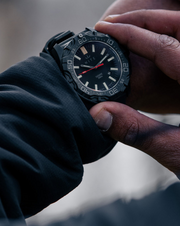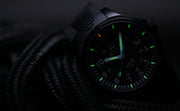Key Takeaways:
- Borosilicate glass tubes withstand internal tritium gas pressure for decades
- Phosphor coating inside tubes determines colour and brightness efficiency
- T25 tubes contain up to 25 millicuries whilst T100 holds 25-100 millicuries
- Higher gas pressure in T100 tubes produces roughly four times the brightness
- Hermetic sealing prevents tritium escape for 20-year performance
- Manufacturing precision directly impacts long-term reliability
Understanding Tritium Tube Manufacturing Process
When you look at your watch glowing in complete darkness, you’re seeing something quite remarkable. Those tiny tubes aren’t painted with luminous material that fades after a few hours. They’re sealed capsules containing pressurised radioactive gas that glows continuously for many years without charging, batteries, or any external power source whatsoever.
The process of manufacturing GTLS (Gaseous Tritium Light Sources) involves four critical stages: The selection , heating and stretching of borosilicate glass, applying exact internal phosphor coating, injecting a specific amount of pressurised tritium gas, and creating a flat ended permanent seal. Microscopic exacting standards are required for each process, or the result will be tubes that simply don’t deliver when you need them.
We've supplied tritium-illuminated equipment where performance isn't negotiable. The MX10 was selected for UK Special Forces not because tritium sounds impressive, but because properly manufactured tubes deliver reliable operation when failure means compromising the mission. Let's examine how quality tritium tubes are made, focusing particularly on the pressurisation process that determines brightness.
Why Glass Quality Determines Field Reliability
Manufacturing begins with selecting glass that can withstand decades of internal pressure without failure. Standard glass simply won't survive because it can't handle the thermal and pressure demands these sealed capsules must endure. Understanding what makes tritium illumination safe and effective starts with materials that won't let you down.
Borosilicate glass handles massive temperature swings whilst maintaining seal integrity. Your watch might sit in a freezing vehicle at minus 20 degrees, then warm significantly during operations. Borosilicate glass handles this without cracking or compromising the seal.
Tube dimensions used in watches generally range from 0.5mm to 1.0mm in diameter and 1.8mm to 12mm in length. The glass wall thickness is between 0.2mm and 0.5mm. Too thin, the tube can’t handle internal pressure long-term. Too thick and you lose brightness.
At the start of the process the glass tubes are a larger diameter which are then super-heated and stretched into smaller diameter tubes. These smaller tubes are then inspected for microscopic imperfections before manufacturing begins. A single air bubble or surface scratch creates a weak point that might fail under constant pressure years down the line.
Phosphor Coating: What Creates the Glow
Once cleaned, tubes receive phosphorous coating. This is what actually produces visible light when tritium's radiation hits it. Different phosphor compounds produce different colours. Green delivers the brightest output because human eyes are most sensitive to green wavelengths. That's why professional watches use green tubes where maximum visibility matters in complete darkness.
The phosphor suspension gets introduced into the tube, rotated to ensure a perfect internal coverage, then excess is removed. Getting uniform coating thickness matters because thin spots create dark patches whilst thick spots reduce light transmission. These precision techniques are what separate the most durable watches for tactical use from alternatives that fail under pressure.
After coating, tubes are fired at controlled temperatures. This bonds the phosphor permanently to the glass and removes solvents. The coating thickness measures between 20 and 50 micrometres, optimized to capture Beta radiation whilst allowing maximum light through.
Tritium Gas Pressurisation: The Critical Stage
This is where manufacturing becomes genuinely complex, and where quality separates reliable equipment from kit that fails. Tritium gas must be injected at precise pressures, then sealed without losing pressure or introducing contamination. This happens inside specialized gloveboxes under inert atmosphere.
Each tube connects to a vacuum system that pulls out every bit of air. Then the system introduces tritium at target pressure, typically 1 to 3 atmospheres above normal air pressure. These sealed tubes must maintain this pressure for 20 years without degradation.
The injection process achieves precise activity levels measured in millicuries. This is where the distinction between T25 and T100 brightness levels becomes critical, as different activity levels require different pressurisation approaches.
Quality manufacturers complete the entire injection-to-seal process in under 30 seconds to maintain precise pressure. The pressurisation requires extraordinary precision, hitting target activity levels within plus or minus 2 millicuries to ensure uniform brightness across all markers. Miss these tolerances and you'll see noticeable brightness variations between tubes.
Hermetic Sealing: Containing Pressure for Decades
After tritium injection, manufacturers permanently seal the tube whilst maintaining internal pressure. This is the most critical step because the seal must contain pressurised tritium for two decades without degradation.
The sealing process uses precision flame sealing or laser welding. Both methods must achieve perfect seals because even microscopic imperfections allow tritium to slowly escape. We've seen what happens when seals aren't manufactured to proper standards - brightness drops noticeably within five years instead of maintaining output for two decades.
During sealing, the tube remains connected to pressure monitoring. If pressure drops even slightly, it indicates incomplete fusion. Quality manufacturers reject any tube showing pressure loss because a seal that drops even 0.1 atmospheres suggests future failure.
The seal point becomes the tube's structural weak spot. Manufacturers use controlled cooling cycles to relieve internal stresses. Rapid cooling creates stress concentrations that can crack months later. It's like welding metal - rush the cooling and you'll get cracks eventually.
After sealing, tubes undergo leak testing using sensitive detection methods. The entire sealing process happens under inert atmosphere to prevent contamination. Even trace amounts of oxygen inside the sealed tube will react with tritium and reduce brightness over time.
Why We Demand Swiss Manufacturing Standards
Before any tritium tube enters our watches, it must pass multiple verification stages confirming pressure integrity, brightness output, and structural soundness.
Brightness testing happens in standardised dark chambers using calibrated equipment. Any tube falling outside specification gets rejected immediately. Pressure verification includes immediate and delayed testing at 48 to 72 hours. Delayed testing catches slow leaks that might not appear in immediate inspection.
Sample tubes undergo mechanical stress testing and thermal cycling from minus 40 to plus 80 degrees, replicating conditions you'd encounter operationally. Visual inspection under magnification catches surface defects, phosphor inconsistencies, or seal irregularities that automated testing might miss.
We specify Swiss-manufactured tubes from mb-microtec because they undergo these rigorous quality control processes, ensuring every tube meets the standards required for professional applications. When every second counts, trust what's on your wrist.
What Manufacturing Quality Means Operationally
Manufacturing precision affects long-term value. Premium tritium tubes maintaining brightness for 15 to 20 years represent better value than alternatives fading within fewer years. That matters when you're selecting equipment for serious use.
Proper phosphor application creates strong chemical bonds between phosphor and glass. We've tested tubes where the phosphor has migrated to the bottom because the bonding process wasn't done properly. The bottom glows brightly, the top barely glows at all. Rather useless for reading time in the field.
Seal integrity determines tritium retention over time. Quality sealing prevents gas escape and pressure loss, maintaining brightness at expected levels. The 20-year performance specification is achievable with proper manufacturing standards. We've verified tubes from premium manufacturers produced over 15 years ago still delivering practical illumination. Forged in the field, proven by professionals.
Selecting Watches with Quality Tube Manufacturing
Understanding tube manufacturing explains why premium tritium watches command higher prices. When evaluating tritium watches, tube sourcing matters significantly. We state clearly that NITE watches use Swiss-manufactured tubes, reflecting our confidence in manufacturing quality that won't let you down operationally.
Performance in demanding conditions depends entirely on manufacturing quality. If you're timing a dive at 30 metres, navigating after sunset, or operating where reading time clearly matters, tubes manufactured to rigorous standards deliver the reliability you need when failure isn't an option. Purpose-built. Field-tested. Adventure-ready.
For those considering professional diving applications or tactical use, understanding these manufacturing processes helps explain why certain watches maintain consistent performance throughout their service life.
The pressurisation process, phosphor application, and hermetic sealing represent engineering challenges that separate quality tritium illumination from alternatives. Understanding these manufacturing stages helps you make informed decisions about tritium watch technology and appreciate why proper manufacturing delivers reliable performance when it matters most. Engineered to endure. Designed to perform.
Frequently Asked Questions
How long does it take to manufacture tritium watch tubes?
Tritium tube manufacturing takes 2 to 3 weeks per production batch. Key steps include phosphor curing (several days), seal verification (48-72 hours), and delayed pressure testing (30 days). Verification stages require extended periods to ensure 20-year reliability under constant internal pressure.
Can tritium tubes be refilled or recharged?
No, tritium tubes cannot be refilled or recharged. Once sealed, they are permanent devices. The hermetic seal that contains the pressurised tritium makes the tube impossible to open without destroying it. When tubes dim after 15 to 20 years, complete replacement with new tubes is the only option.
Why does proper sealing matter for tritium tubes?
Proper sealing is critical because even microscopic imperfections allow pressurised tritium gas to slowly escape over time. The seal must contain gas at 1 to 3 atmospheres above normal pressure for 20 years without degradation. Quality manufacturers use controlled cooling cycles to relieve stress and conduct leak testing to verify seal integrity.
How is consistent brightness achieved between tritium tubes?
Manufacturers ensure consistent brightness through precise gas pressure control during tritium injection, target activity levels within ±2 millicuries tolerance, automated filling systems monitoring pressure and timing, individual brightness verification using calibrated equipment, and rejection of any tubes outside specification before assembly.
What happens during the phosphor coating stage?
During phosphor coating, a precisely formulated mixture of phosphor crystals is introduced into the glass tube, which is then rotated to ensure complete internal coverage. The tube is fired at controlled temperatures to permanently bond the phosphor to the glass. The coating thickness of 20-50 micrometres is optimized to capture radiation from tritium whilst allowing maximum light transmission.















